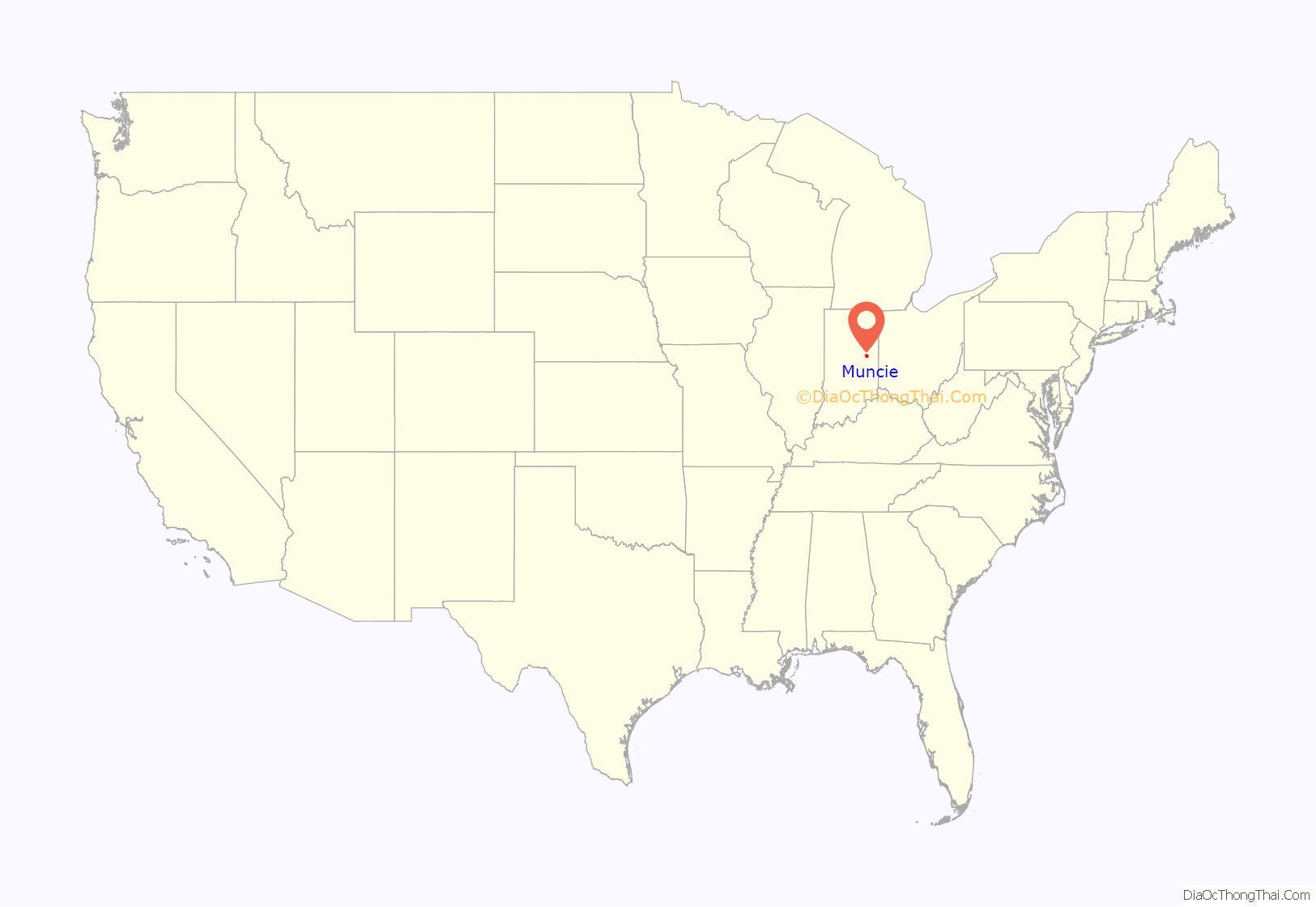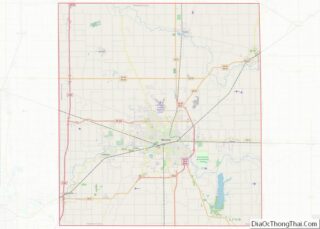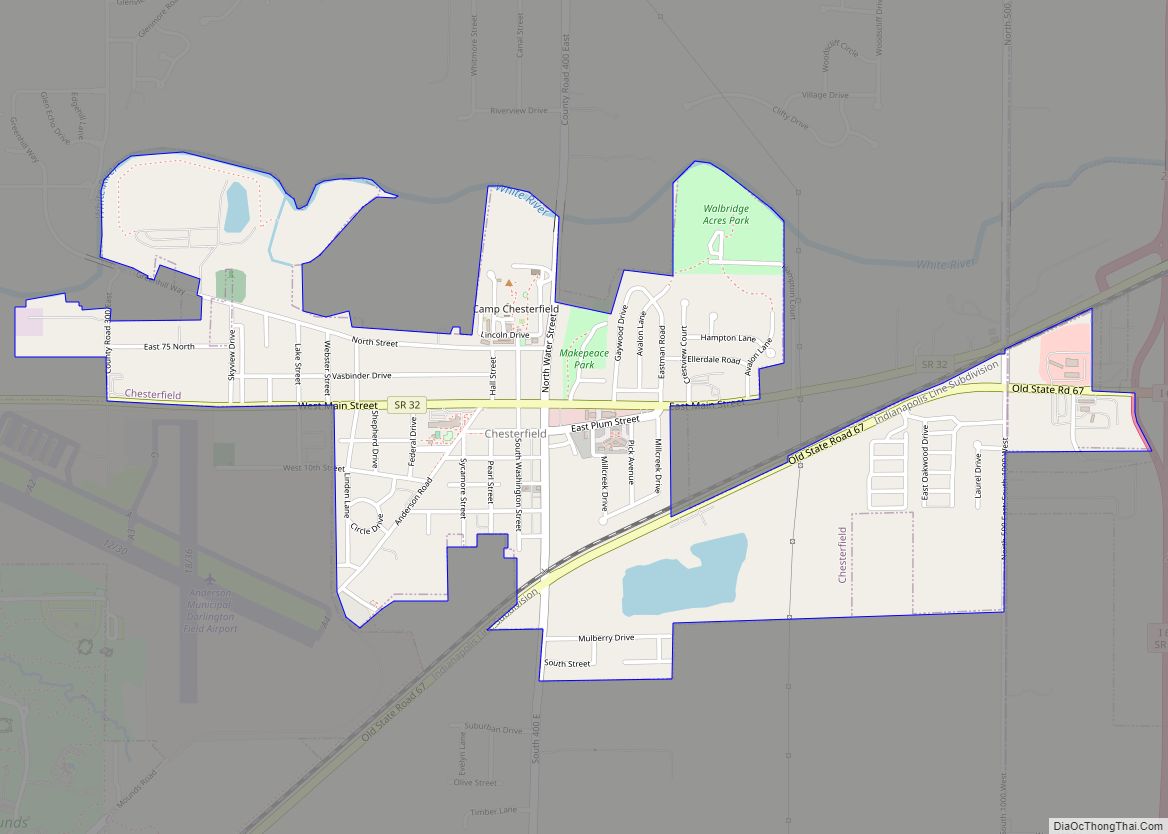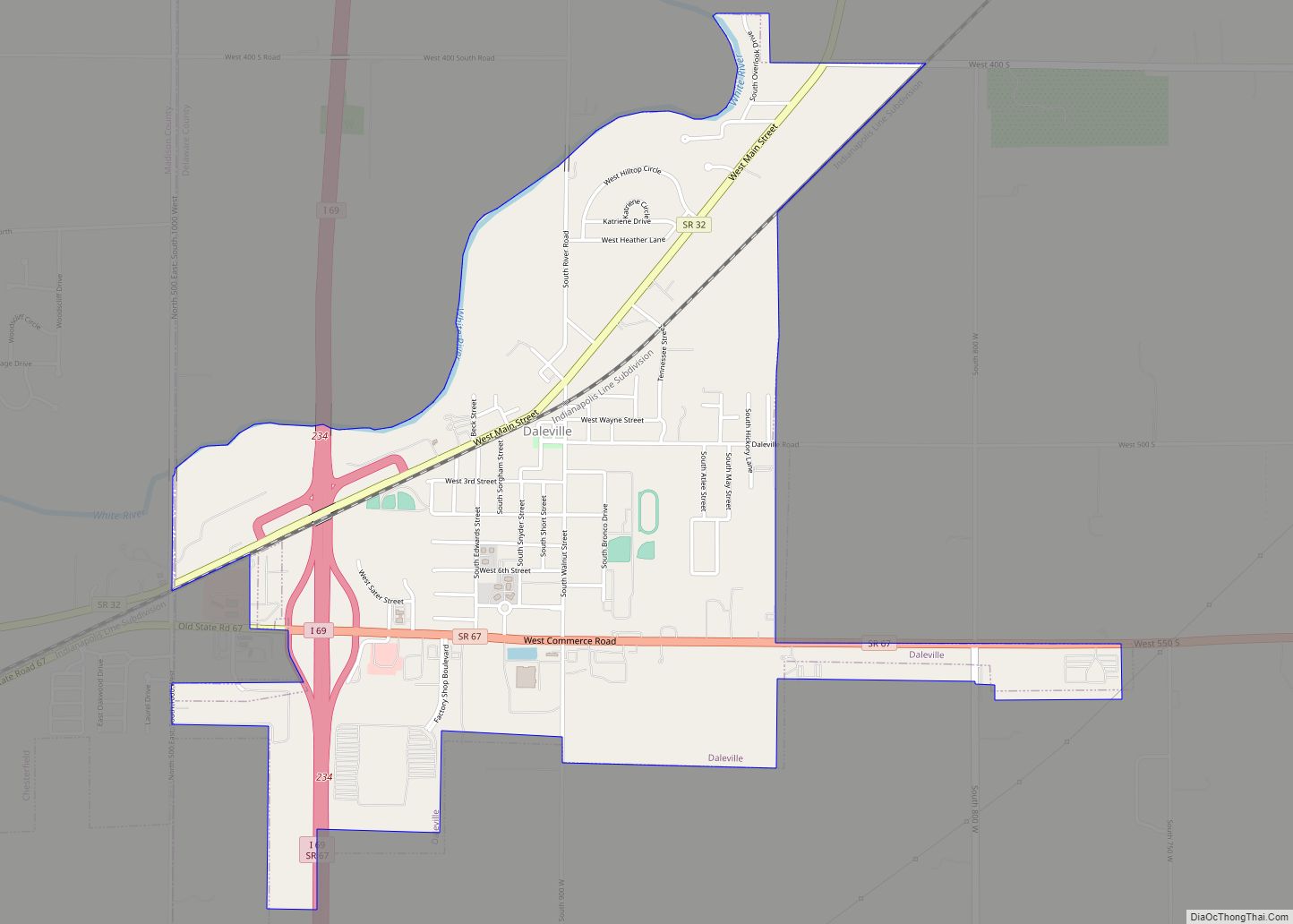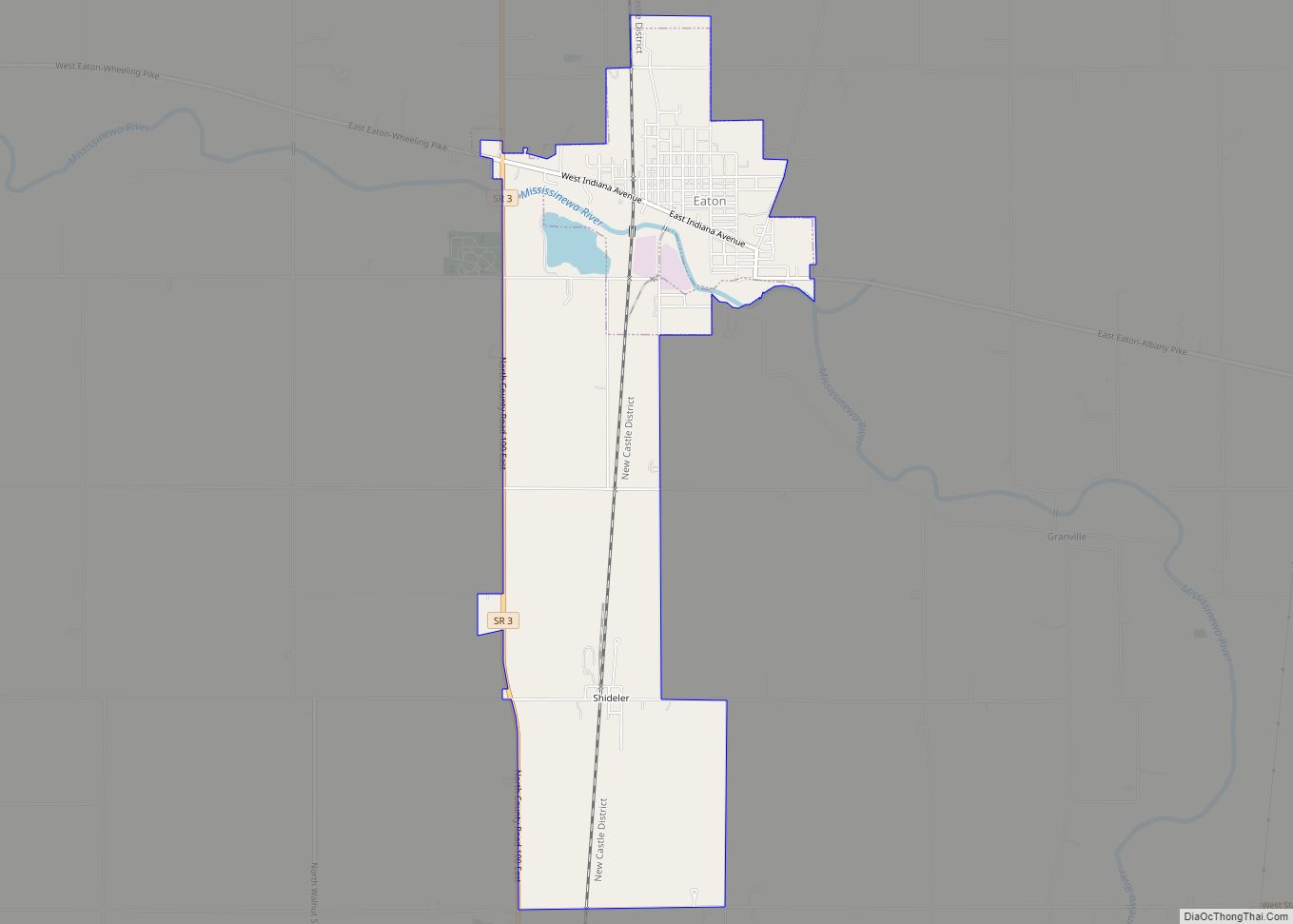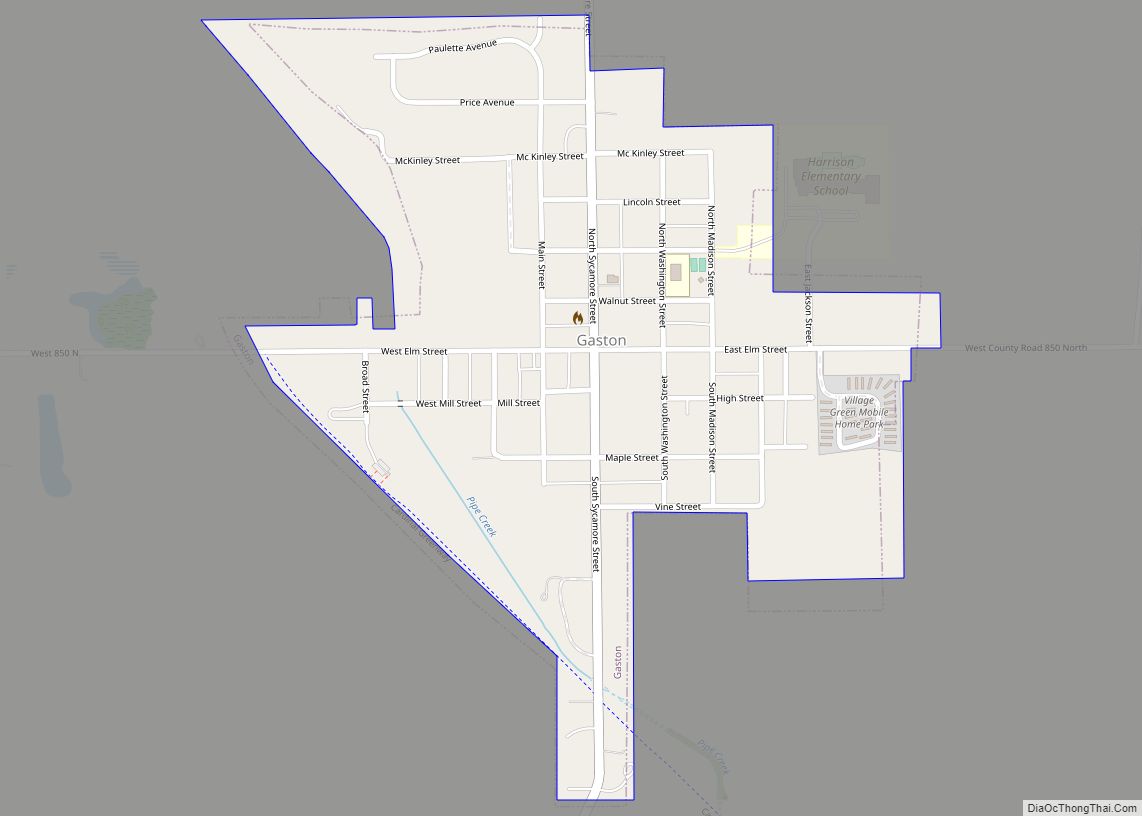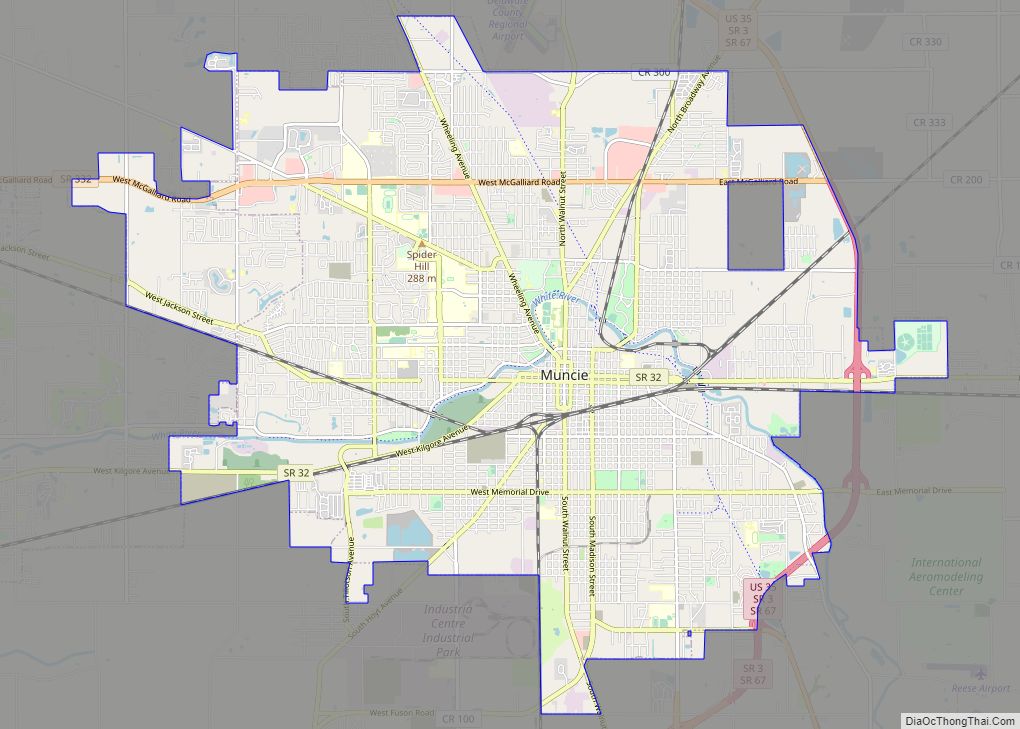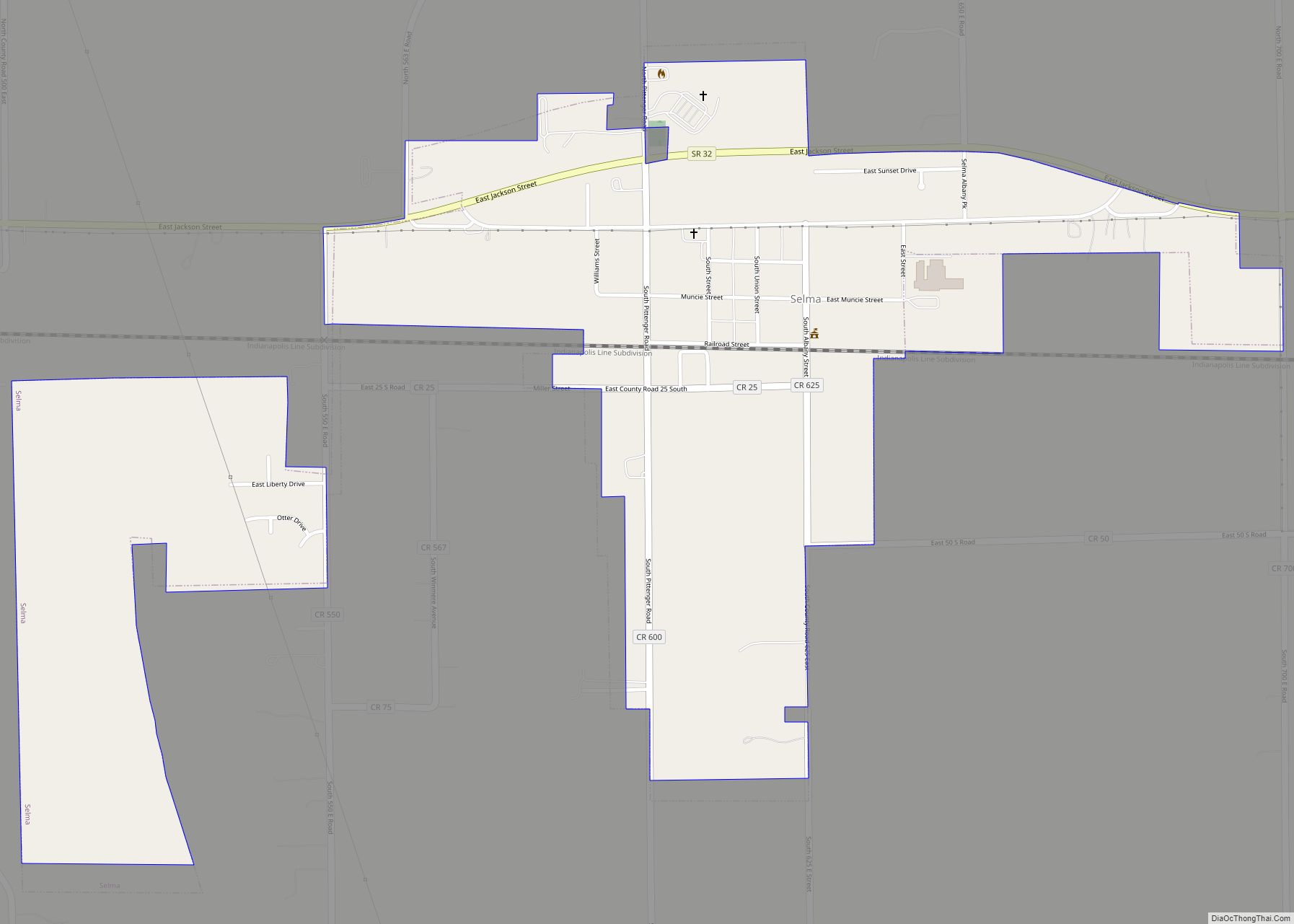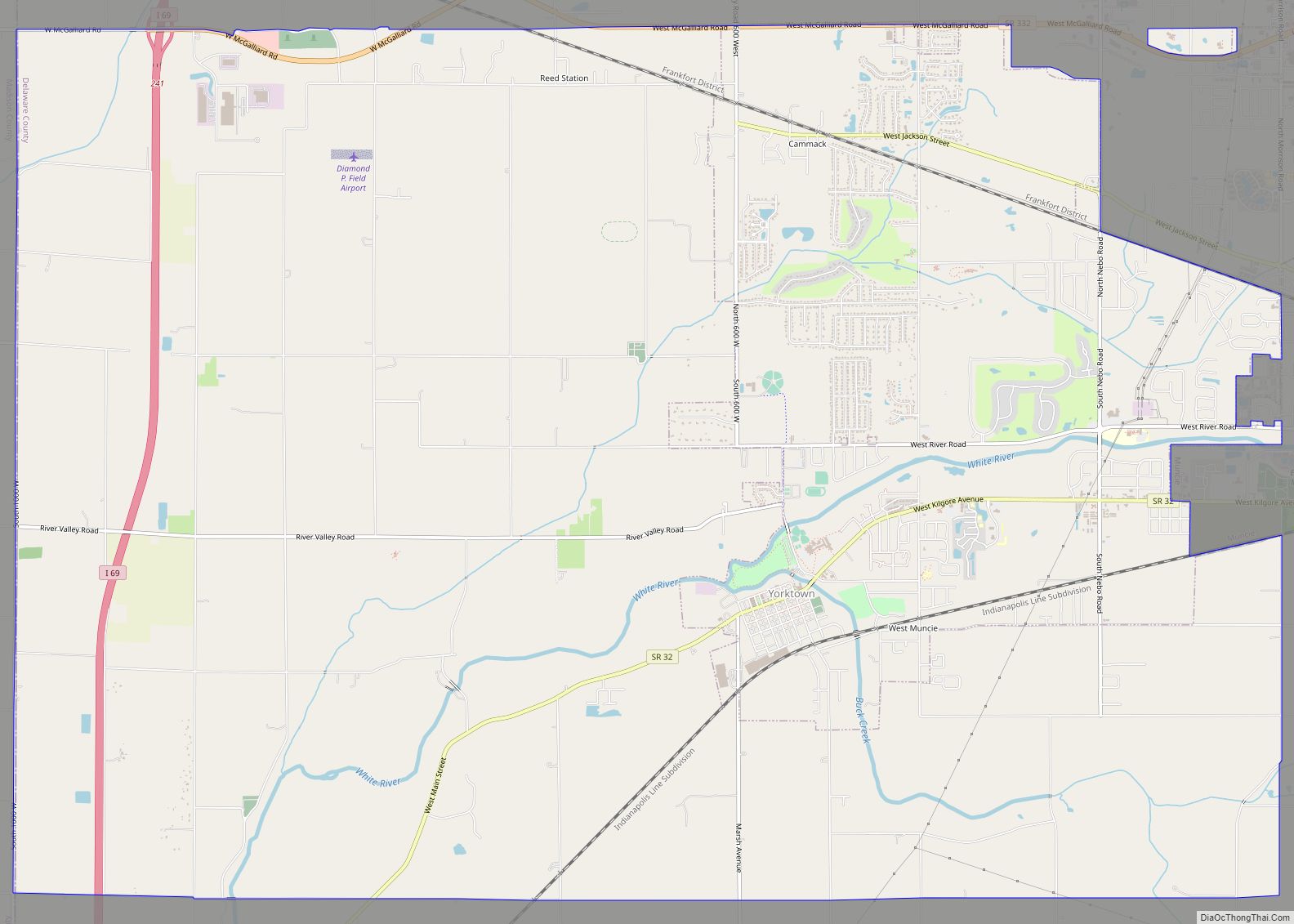Muncie (/ˈmʌnsi/ MUN-see) is an incorporated city and the seat of Delaware County, Indiana. Previously known as Buckongahelas Town, named after the legendary Delaware Chief. It is located in East Central Indiana, about 50 miles (80 km) northeast of Indianapolis. The United States Census for 2020 reported the city’s population was 65,194. It is the principal city of the Muncie metropolitan statistical area, which has a population of 117,671.
The Lenape (Delaware) people, led by Buckongahelas arrived in the area in the 1790s, founding several villages, including one known as Munsee Town, along the White River. The trading post, renamed Muncietown, was selected as the Delaware County seat and platted in 1827. Its name was officially shortened to Muncie in 1845 and incorporated as a city in 1865. Muncie developed as a manufacturing and industrial center, especially after the Indiana gas boom of the 1880s. It is home to Ball State University. As a result of the Middletown studies, sociological research that was first conducted in the 1920s, Muncie is said to be one of the most studied United States cities of its size.
| Name: | Muncie city |
|---|---|
| LSAD Code: | 25 |
| LSAD Description: | city (suffix) |
| State: | Indiana |
| County: | Delaware County |
| Founded: | 1827 |
| Elevation: | 932 ft (284 m) |
| Total Area: | 27.60 sq mi (71.49 km²) |
| Land Area: | 27.40 sq mi (70.98 km²) |
| Water Area: | 0.20 sq mi (0.51 km²) |
| Total Population: | 65,194 |
| Population Density: | 2,379.00/sq mi (918.54/km²) |
| Area code: | 765 |
| FIPS code: | 1851876 |
| GNISfeature ID: | 0439878 |
| Website: | www.cityofmuncie.com |
Online Interactive Map
Click on ![]() to view map in "full screen" mode.
to view map in "full screen" mode.
Muncie location map. Where is Muncie city?
History
Early settlement
The area was first settled in the 1790s by the Lenape (Delaware) people, who were forced west from their tribal lands in the Mid-Atlantic region (all of New Jersey, southeastern New York, eastern Pennsylvania, and northern Delaware) to new lands in present-day Ohio and eastern Indiana. The Lenape founded several towns along the White River, including Munsee Town, near the site of present-day Muncie.
Contrary to popular legend, the city’s early name of Munsee Town is derived from the “Munsee” clan of Lenape people, the white settlers’ name for a group of Native Americans whose village was once situated along the White River. There is no evidence that a mythological Chief Munsee ever existed. (“Munsee” means a member of or one of their languages.)
In 1818, the area’s native tribes ceded their lands to the federal government under the terms of the Treaty of St. Mary’s and agreed to move farther west by 1821. New settlers began to arrive in what became Delaware County, Indiana, about 1820, shortly before the area’s public lands were formally opened for purchase. The small trading village of Munsee Town, renamed Muncietown, was selected as the Delaware County seat and platted in 1827. On January 13, 1845, Indiana’s governor signed legislation passed by the Indiana General Assembly to shorten the town’s name to Muncie. Soon, a network of roads connected Muncie to nearby towns, adjacent counties, and to other parts of Indiana. The Indianapolis and Bellefontaine Railroad, the first to arrive in Muncie in 1852, provided the town and the surrounding area with access to larger markets for its agricultural production, as well as a faster means of transporting people and goods into and out of the area.
Muncie incorporated as a town on December 6, 1854, and became an incorporated city in 1865. John Brady was elected as the city’s first mayor. Muncie’s early utility companies also date to the mid-1860s, including the city’s waterworks, which was established in 1865.
After the American Civil War, two factors helped Muncie attract new commercial and industrial development: the arrival of additional railroads from the late 1890s to the early 1900s and the discovery of abundant supplies of natural gas in the area. Prior to the discovery of nearby natural-gas wells and the beginning of the gas boom in Muncie in 1886, the region was primarily an agricultural area, with Muncie serving as the commercial trading center for local farmers.
Industrial and civic development
The Indiana gas boom of the 1880s ushered in a new era of prosperity to Muncie. Abundant supplies of natural gas attracted new businesses, industries, and additional residents to the city. Although agriculture continued to be an economic factor in the region, industry dominated the city’s development for the next 100 years. One of the major manufacturers that arrived early in the city’s gas-boom period was the Ball Brothers Glass Manufacturing Company, which was renamed the Ball Corporation in 1969. The Ball brothers, who were searching for a new site for their glass manufacturing business that was closer to an abundant natural-gas supply, built a new glass-making foundry in Muncie, beginning its glass production on March 1, 1888. In 1889 the company relocated its metal manufacturing operations to Muncie.
In addition to several other glass factories, Muncie attracted iron and steel mills. Kitselman Steel & Wire Company was the largest employer in Indiana in 1900 with 11,000 employees; it later became Indiana Steel & Wire. Others included Republic Iron and Steel Company and the Midland Steel Company. (Midland became Inland Steel Company and later moved to Gary, Indiana.) Indiana Bridge Company was also a major employer. By the time the natural gas supply from the Trenton Gas Field had significantly declined and the gas boom ended in Indiana around 1910, Muncie was well established as an industrial town and a commercial center for east-central Indiana, especially with several railroad lines connecting it to larger cities and the arrival of automobile industry manufacturing after 1900.
Numerous civic developments also occurred as a result of the city’s growth during the 1870s, 1880s, and 1890s, when Muncie citizens built a new city hall, a new public library, and a new high school. The city’s gasworks also began operations in the late 1870s. The Muncie Star was founded in 1899 and the Muncie Evening Press was founded in 1905. A new public library, which was a Carnegie library project, was dedicated on January 1, 1904, and served as the main branch of the city’s public library system.
The forerunner to Ball State University also arrived in the early twentieth century. Eastern Indiana Normal School opened 1899, but it closed after two years. Several subsequent efforts to establish a private college in Muncie during the late nineteenth and early twentieth centuries also failed, but one proved to be very successful. After the Ball brothers bought the school property and its vacant buildings and donated them to the State of Indiana, the Indiana State Normal School, Eastern Division, the forerunner to Ball State University, opened in 1918. It was named Ball Teachers College in 1922, Ball State Teachers College in 1929, and Ball State University in 1965.
Beginning in the late nineteenth century, in tandem with the gas boom, Muncie developed an active cultural arts community, which included music and art clubs, women’s clubs, self-improvements clubs, and other social clubs. Hoosier artist J. Ottis Adams, who came to Muncie in 1876, later formed an art school in the city with fellow artist, William Forsyth. Although their school closed with a year or two, other art groups were established, most notably the Art Students’ League (1892) and the Muncie Art Association (1905).
By the early twentieth century several railroads served Muncie, which helped to establish the city as a transportation hub. The Cincinnati, Richmond and Muncie Railroad (later known as the Chesapeake and Ohio Railway) reached Muncie in 1903. The Chicago, Indiana, and Eastern Railroad (acquired by a subsidiary of the Pennsylvania Railroad system) and the Chicago and Southeastern (sometimes called the Central Indiana Railroad) also served the city. In addition to the railroads, Muncie’s roads connected to nearby towns and an electric interurban system, which arrived in the early 1900s, linked it to smaller towns and larger cities, including Indianapolis and Fort Wayne, Indiana, and Dayton, Ohio.
With the arrival of the auto manufacturing and the related auto parts industry after the turn of the twentieth century, Muncie’s industrial and commercial development increased, along with its population growth. During World War I local manufacturers joined others around the county in converting their factories to production of war material. In the 1920s Muncie continued its rise as an automobile-manufacturing center, primarily due to its heavy industry and skilled labor force. During this time, the community also became a center of Ku Klux Klan activity. Muncie’s Klan membership was estimated at 3,500 in the early 1920s. Scandals within the Klan’s leadership, divisions among its members, and some violent confrontations with their opponents damaged the organization’s reputation. Increasing hostility toward the Klan’s political activities, beliefs, and values also divided the Muncie community, before its popularity and membership significantly declined by the end of the decade.
Muncie residents also made it through the challenges of the Great Depression, with the Ball brothers continuing their role as major benefactors to the community by donating funds for construction of new facilities at Ball State and Ball Memorial Hospital. (The hospital, which opened in 1929, later affiliated with Indiana University Health.) The Works Progress Administration (WPA) also provided jobs such as road grading, city sewer improvements, and bridge construction.
Middletown studies
In the 1920s, Robert and Helen Lynd led a team of sociologists in a study of a typical middle-American community. The Lynds chose Muncie as the locale for their field research, although they never specifically identified it as “Middletown” the fictional name of the town in their study. Muncie received national attention after the publication of their book, Middletown: A Study in Contemporary American Culture (1929). The Lynds returned to Muncie to re-observe the community during the Depression, which resulted in a sequel, Middletown in Transition: A Study in Cultural Conflicts (1937). The Lynds’ Middletown study, which was funded by the Rockefeler Institute of Social and Religious Research, was intended to study “the interwoven trends that are the life of a small American city.”
The Lynds were only the first to conduct a series of studies in Muncie. The National Science Foundation funded a third major study that resulted in two books by Theodore Caplow, Middletown Families (1982) and All Faithful People (1983). Caplow returned to Muncie in 1998 to begin another study, Middletown IV, which became part of a Public Broadcasting Service documentary titled “The First Measured Century”, released in December 2000. The Ball State Center for Middletown Studies continues to survey and analyze social change in Muncie. A database of Middletown surveys conducted between 1978 and 1997 is available online from the Association of Religion Data Archives (ARDA). Due to the extensive information collected from the Middletown studies during the twentieth century, Muncie is said to be one of the most studied cities of its size in the United States.
In addition to being called a “typical American city”, as the result of the Middletown studies, Muncie is known as Magic City or Magic Muncie, as well as the Friendly City.
World War II to the present
During World War II the city’s manufacturers once again turned their efforts to wartime production. Ball State and Muncie’s airport also trained pilots for the U.S. Navy. The postwar era was another period of expansion for Muncie, with continued growth and development of industries, construction of new homes, schools, and businesses. A population boom brought further development, especially from 1946 to 1965.
Since the 1950s and 1960s Muncie has continued as an education center in the state and emerged as a regional health center. As enrollment at Ball State increased, new buildings were erected on the college’s campus. Ball Memorial Hospital also expanded its facilities. However, by the 1960s, industrial trends had shifted. Beginning in the 1970s several manufacturing plants closed or moved elsewhere, while others adapted to industrial changes and remained in Muncie. Ball Corporation, for example, closed its Muncie glass manufacturing facilities in 1962 and its corporate headquarters relocated to Broomfield, Colorado in 1998. Muncie was also home to other manufacturing operations, including Warner Gear (a division of BorgWarner), Delco Remy, General Motors, Ontario Corporation, A. E. Boyce Company, and Westinghouse Electric, among others.
In 2017, the Muncie Community Schools system was declared a “distressed political subdivision”, and put in direct control of the state government. In 2018, the school district was reformed and a new board was appointed by Ball State’s Board of Trustees.
In 2021, following the Fall of Kabul and the U.S. withdrawal from the War in Afghanistan, several Afghan refugees arrived in Camp Atterbury, near Edinburgh, Indiana. Munsonian members of the nationwide organization, Afghan Women’s and Kids’ Education and Necessities (AWAKEN) formed the Muncie Afghan Refugee Resettlement Committee (MARRC) to help Afghan refugees resettle in Muncie. Afghan refugees began arriving in Muncie soon after. As the AWAKEN organization wanted to continue work directly in Afghanistan, the temporary MARRC organization was closed. However, the presence of 130 Afghan refugees in Muncie in late 2022 compelled continued work in medical advocacy, employment, legal aid, and financial and reading education. A new organization, Refugee Alliance of Delaware County (RADC), was formed to welcome any refugees in Muncie and help them in establishing and building a new life.
African-American history
The black population in Muncie grew from 3.7% in 1890, to 5.6% in 1920, and to 13.2% in 2013. In 1920, the city had the fifth-largest black population in Indiana with 2,054 black residents. Two major parades were held by the Ku Klux Klan in 1922 and 1924, with the mayor and police chief attending the 1924 parade. The first black police officer in Muncie was hired in 1899, and the city’s first black police chief took his position in 1995. The first black teacher in the city was hired in 1952, and the first black principal was appointed in 1956.
According to Hurley Goodall, the first serious black political candidate in Muncie was Wayne Brooks, who ran for the Republican nomination for mayor in 1934. Ray Armstrong was elected as the first black member of the city council in 1951 and Alice McIntosh was elected as the first black female member of the city council in 1983. Goodall was the first black person elected to the city’s school board and later to represent the area in the state house. No other black person served Muncie’s school board after Goodall’s election to the state house until Carl Kizer Jr.’s appointment to the board in 1993. The school board became majority black for the first time after the 2008 election.
Muncie Road Map
Muncie city Satellite Map
Geography
According to the 2010 census, Muncie has a total area of 27.392 square miles (70.94 km), of which 27.2 square miles (70.45 km) (or 99.3%) is land and 0.192 square miles (0.50 km) (or 0.7%) is water.
Climate
Muncie has a humid continental climate (Köppen climate classification Dfa) experiencing four distinct seasons.
Neighborhoods
Muncie has over 50 identified neighborhoods.
See also
Map of Indiana State and its subdivision:- Adams
- Allen
- Bartholomew
- Benton
- Blackford
- Boone
- Brown
- Carroll
- Cass
- Clark
- Clay
- Clinton
- Crawford
- Daviess
- De Kalb
- Dearborn
- Decatur
- Delaware
- Dubois
- Elkhart
- Fayette
- Floyd
- Fountain
- Franklin
- Fulton
- Gibson
- Grant
- Greene
- Hamilton
- Hancock
- Harrison
- Hendricks
- Henry
- Howard
- Huntington
- Jackson
- Jasper
- Jay
- Jefferson
- Jennings
- Johnson
- Knox
- Kosciusko
- LaGrange
- Lake
- Lake Michigan
- LaPorte
- Lawrence
- Madison
- Marion
- Marshall
- Martin
- Miami
- Monroe
- Montgomery
- Morgan
- Newton
- Noble
- Ohio
- Orange
- Owen
- Parke
- Perry
- Pike
- Porter
- Posey
- Pulaski
- Putnam
- Randolph
- Ripley
- Rush
- Saint Joseph
- Scott
- Shelby
- Spencer
- Starke
- Steuben
- Sullivan
- Switzerland
- Tippecanoe
- Tipton
- Union
- Vanderburgh
- Vermillion
- Vigo
- Wabash
- Warren
- Warrick
- Washington
- Wayne
- Wells
- White
- Whitley
- Alabama
- Alaska
- Arizona
- Arkansas
- California
- Colorado
- Connecticut
- Delaware
- District of Columbia
- Florida
- Georgia
- Hawaii
- Idaho
- Illinois
- Indiana
- Iowa
- Kansas
- Kentucky
- Louisiana
- Maine
- Maryland
- Massachusetts
- Michigan
- Minnesota
- Mississippi
- Missouri
- Montana
- Nebraska
- Nevada
- New Hampshire
- New Jersey
- New Mexico
- New York
- North Carolina
- North Dakota
- Ohio
- Oklahoma
- Oregon
- Pennsylvania
- Rhode Island
- South Carolina
- South Dakota
- Tennessee
- Texas
- Utah
- Vermont
- Virginia
- Washington
- West Virginia
- Wisconsin
- Wyoming
